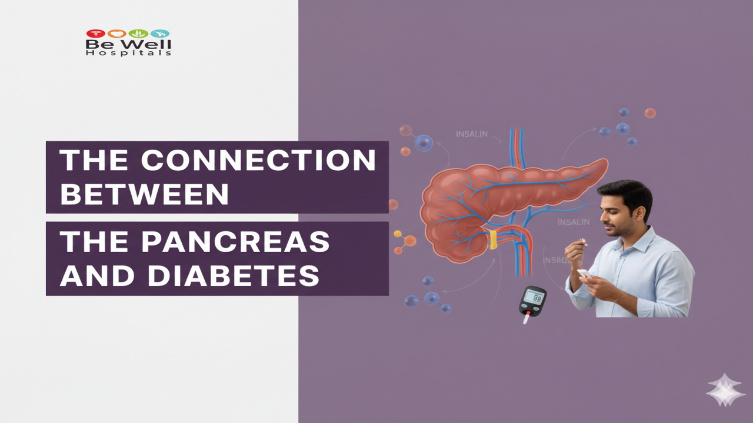
Introduction
The pancreas, though small and tucked behind the stomach, plays one of the most vital roles in maintaining our body’s energy balance. It produces insulin and glucagon — two hormones that regulate how our body uses and stores glucose, the main source of energy. When the pancreas doesn’t function properly, this balance is disrupted, leading to elevated blood sugar levels and conditions like diabetes. Understanding how the pancreas influences diabetes helps in early detection, prevention, and better management of this chronic disease.
The Pancreas: Guardian of Blood Sugar Balance
Every time we eat, carbohydrates break down into glucose, which enters the bloodstream. The pancreas immediately responds by releasing insulin, a hormone that helps cells absorb glucose for energy or store it as glycogen in the liver and muscles. This process keeps blood sugar levels from rising too high after meals.
When blood sugar drops — such as between meals or during physical activity — the pancreas releases glucagon, another hormone that prompts the liver to convert stored glycogen into glucose, keeping levels steady.
This continuous cycle of insulin and glucagon ensures the body has a consistent energy supply. However, when the pancreas becomes strained or damaged, it can’t maintain this balance — setting the stage for diabetes.
How Pancreatic Dysfunction Leads to Diabetes
In diabetes, the pancreas either doesn’t produce enough insulin or the body becomes resistant to it. Over time, this leads to persistently high blood sugar levels, which can harm the heart, kidneys, nerves, and other vital organs.
In Type 1 diabetes, the immune system mistakenly destroys the pancreas’s insulin-producing beta cells. As a result, little or no insulin is made, and glucose accumulates in the bloodstream. This form usually develops in childhood or adolescence and requires lifelong insulin therapy.
In Type 2 diabetes, insulin is still produced but the body’s cells don’t respond properly — a condition called insulin resistance. The pancreas tries to compensate by making more insulin, but eventually becomes exhausted, leading to elevated blood sugar. Type 2 diabetes is often linked to obesity, sedentary habits, and poor diet.
Both conditions highlight how critical pancreatic function is for maintaining metabolic balance.
Warning Signs of Pancreatic Trouble

The pancreas often suffers silently before problems become noticeable. Be alert to symptoms that may signal pancreatic distress or early blood sugar imbalance:
- Persistent pain in the upper abdomen that may radiate to the back
- Unexplained weight loss even without changes in diet or activity
- Constant fatigue or weakness due to poor glucose utilization
- Bloating, indigestion, or oily stools indicating poor fat digestion
- Nausea, vomiting, or loss of appetite
- Fluctuating blood sugar readings
- Increased thirst and frequent urination
- Yellowing of skin or eyes (jaundice)
- Back pain after eating
Recognizing these signs early and consulting a doctor can help prevent serious complications like pancreatitis or diabetes.
Lifestyle Habits to Support a Healthy Pancreas
Protecting pancreatic health starts with consistent, mindful habits that reduce stress on the organ and improve overall metabolism:
- Eat a balanced diet rich in fruits, vegetables, whole grains, and lean proteins.
- Cut down on sugary and processed foods that overwork insulin production.
- Choose healthy fats like olive oil, avocados, and nuts over trans fats.
- Stay hydrated to support digestion and detoxification.
- Exercise regularly for at least 30 minutes daily to boost insulin sensitivity.
- Maintain a healthy weight to prevent insulin resistance.
- Avoid smoking and limit alcohol, both of which can damage pancreatic tissue.
- Manage stress through meditation or relaxation techniques.
- Get regular health checkups and blood sugar screenings.
Small daily choices can make a lasting difference in preserving pancreatic function and preventing diabetes.
Medical Advances and Hope for the Future
Recent breakthroughs in diabetes research are reshaping how pancreatic health is managed. Technologies like insulin pumps and continuous glucose monitoring (CGM) devices now allow precise, real-time blood sugar control. Even more advanced are artificial pancreas systems, which automatically deliver insulin based on glucose readings — closely mimicking the body’s natural process.
Medications such as GLP-1 receptor agonists and SGLT2 inhibitors have also transformed diabetes treatment by not only lowering blood sugar but improving heart and kidney health. Emerging research in stem cell therapy and islet cell transplantation holds promise for regenerating insulin-producing cells, offering hope for a long-term cure.
As science progresses, managing diabetes is becoming less invasive and more personalized — turning what was once a lifelong challenge into a condition that can be effectively controlled.
Conclusion
The pancreas might be small, but its role in sustaining life is immense. When it functions well, your body uses energy efficiently and remains in balance. When it falters, conditions like diabetes can emerge silently but impact nearly every organ.
By understanding how the pancreas works, staying alert to warning signs, and adopting healthy habits, we can protect this vital organ and reduce the risk of diabetes. Early medical attention, combined with today’s advanced treatments, can make management easier and outcomes better.
Take care of your pancreas — nourish it with good food, stay active, and make preventive checkups a routine. A healthy pancreas means stable energy, balanced blood sugar, and a stronger, more vibrant life.
For expert diabetic and pancreatic care, visit Be Well Hospitals or call 9698 300 300 to book an appointment and take charge of your health today.
